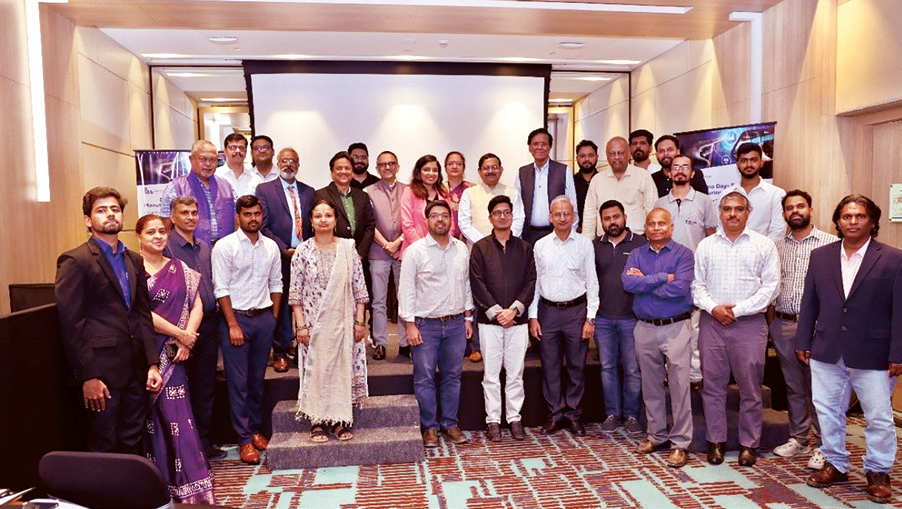
KASUTI, the Hand woven Poetry
Ranjani Govind
When popular playback singer Ankita Kundu walked into the arts revival boutique Madhurya to see some of the handloom specials showcased for Shivaratri, she was magnetically pulled towards Karnataka’s Kasuti embroidery on Illkal sari, owing to its “spread of native folk embellishment.”
Karnataka’s well-known needle-andthread-play, Kasuti, seemed special to the young Kannada playback and Hindustani vocalist who loves wearing handloom.
Emotionally drawn towards the intricate handwork, she says, “I can visualize those talented women sitting in groups to handle them all together amidst their chatter-and-song (for weeks together) to have this sari made. It’s their relentless spirit for art that has God in the detailing!”
“While Karnataka’s sandalwood, Mysore Silk, wooden toys of Channapatna and Bidriware have always garnered spotlight, the delicate looking and painstakingly created Kasuti embroidery has been waiting patiently to grab the required attention! Nevertheless, its aesthetic doctrine has caught the eye of textile researchers, fashion designers and art restoration hubs - over the last few years.
“It is for us to recognize and revive,” says Bharathy Harish, designer and head of Madhurya that sources Kasuti worked saris directly from north Karnataka.
“It is said, Kasuti was born when discarded silk threads were collected by women involved in embroidery and used for creating patterns with the needle for vantage value-additions in bridal trousseau. Especially the Chandrakali or the black silk sari with Kasuti embroidery which were part of every auspicious occasion. A closer look will reveal a storehouse of designs, identical on both sides, created by women as they observed the world,” she explains.
Tracing its origin
Kasuti derives its name from the words - Kai (hand) and Suti (cotton) in Kannada to signify a task that requires cotton and hands.
Some researchers believe it originated in the 7th Century AD in north Karnataka. Women thrived as artisans in this stunningly nuanced embroidery (that has earned a Geographical Indication) under the rule of the Chalukya dynasty and the Mysore Kingdom in the 17th Century.
A senior Kasuti artist from Hubli, Ramakka Joshi, recalls her grandmother saying that out of the 64 art forms that every kingdom had to be skilled in, Kasuti was one of them, predominantly done by women.
Each woman was supposed to adorn a sari and a blouse featuring the Kasuti handiwork to contribute towards propagating the indigenous art.
The tradition and skills were passed on as a way of life from mothers to daughters.
Technique of the unique art
While earlier they did Kasuti directly on the handloom sari fastidiously keeping a count of the warp and weft threads ensuring a measured and orderly appearance, now nets are used to bring in a synchronized pattern with steel needles.
Special threads are sourced from Mysore, unlike in ancient times when they used raw, silk fabric. Single strand cotton threads from Kohinoor and Anchor have also come into the play in present times.
Identical on both sides with no knots
The technique of this embroidery lies in its four stitches - Gavanti, Negi, Murgi and Menthi—used vertically, horizontally and diagonally.
“The embroidery is carried on without bringing in a single knot or threads hanging lose, making the fabric look fine-textured, with both sides bringing identical design. This is one of the ways to check if the Kasuti work is authentic or not,” says Laxmibai, one of the artists working from Hubli and regularly taking part in Vastrabharana expo.
Gavanti is a traditional line-and-back, double running stitch for forming geometrical designs; Negi, a weaver’s stitch, appears as a non-identical woven design used for elaborate patterns; Murgi is a neat and uniform zig-zag stitch while Menthi, a cross stitch, is named after the fenugreek plant in Kannada.
Design Elements
Laxmibai goes on to describe that folk designs were embroidered onto the fabric, particularly inspired by rangoli patterns in Karnataka.
Since its origin, Kasuti embroidery has thrived as one of India’s celebrated auspicious handicrafts in unorganized sectors. During the regal ceremonies and weddings, gold and silver threads and mirror work were also fused for a majestic look.
Kasuti has grown beyond its usage on cotton and silk-cotton Illkal material, but has hopped onto luxurious Mysore silks and other crepes and Kanjeevaram saris.
The Department of Social Welfare in Karnataka has set up centres for popularizing Kasuti culture.
Gr
 English daily published in Bengaluru & Doha
English daily published in Bengaluru & Doha






